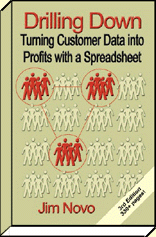How Long is the LifeTime?
Drilling Down
Newsletter
# 60: 9/2005
Drilling Down - Turning Customer
Data into Profits with a Spreadsheet
*************************
Customer Valuation, Retention,
Loyalty, Defection
Get the Drilling Down Book!
http://www.booklocker.com/jimnovo
Prior Newsletters:
http://www.jimnovo.com/newsletters.htm
========================
In This Issue:
# Topics Overview
# Best Customer Retention Articles
# How Long is the LifeTime?
--------------------
Topics Overview
Hi again folks, Jim Novo here.
Did you notice this is Newsletter #60? That means I've been
doing this monthly newsletter for 5 years. Amazing.
This month, we've got LifeTime Value on the plate again.
That's a good thing, because 5 years ago, nobody ever asked about
it. Heck, 5 years ago, people kept asking me why I thought
tracking source of the click to behavior on the web site was so
important...
My, we have come a long way, haven't we?
We also have a couple of great customer marketing article links.
The first provides some meaty info on the paid search market,
including data on conversion by search engine. The second talks
about the different kinds of "alerts" you can create for
Data-Driven marketing and service programs.
To the Drillin'...
Best Customer Marketing Articles
====================
*** Making
Paid Search Pay Off
September 13, 2005 Internet Retailer
This may be old hat to those of you who have been with me for a while, but it's
a great review of the basics and includes some new conversion data on each
search engine.
*** Red
Alert! All Hands Battle Stations!
September 29, 2005 DM Review
Nice overview of the different types of alerts (analytic, sales,
service). Alerts tied to specific KPI's are a great way to
manage a business. By the way, "alerts" don't have to be
pagers going off, they can be monthly reports. Scale alert
timing to the opportunity; if it's going to take 30 days to act in an
economically viable way, you don't need a daily alert. My
favorite is "Defecting Customers by Value" which is
essentially what the LifeCycle
Grid is.
Questions from Fellow Drillers
=====================
How Long is the LifeTime?
Q: First of all thanks for an excellent web site - I often visit it to
learn and / or get inspiration in my work.
A: Thanks for the kind words!
Q: Anyway, I work in a telco retention department and I'm trying to
calculate a true and fair value for customer life time answering the
question : "How long do we on average have a customer ?".
A: A both noble and useful pursuit!
Q: I have data on when customers signed up and when they left (or of course whether they are still here). My first problem is whether to
include
both lost and existing customers in the calculation. If you only include
the customers you lost you are only able to answer the question for
those. If you include existing customers you don't know what life time
to use for them.
A: Well, yes, that's correct. But you're really trying to accomplish several things at the
same time, so you can break the analysis into different parts and then apply some business
logic to get your answers.
Let's assume that for whatever reason, your company attracts two kinds of customers in
terms of their profitability - really profitable ones and really unprofitable ones.
Whether the customer is profitable or not (as is often the case) is a direct function of how long they
remain a customer. So all your disconnected customers are "bad" and all your current customers are "good".
If you analyze the average life of disconnected customers, you will come up with the average
life of a "bad" customer. If you analyze the average life of all current customers, you will
find out the average life of a "good" customer.
These lives could, and perhaps should, be different. Or should
they?
What you may find is the average life of a bad customers is actually longer than the average life of a good customer.
That's an interesting idea, isn't it? What it means is the quality of your customers has been falling over time;
that for some reason you are attracting more "short cycle" customers than you used to.
Conversely, if you find that the average life of current customers is longer than that of
disconnected customers, the quality of customers has been rising over time.
You should also look into the active customer base and do an analysis of customers by life,
for example, % 1 year, % 2 years, % 3 years, etc. Here is what
this typically looks like:
1 year 20%
2 years 40%
3 years 20 %
4 years 15%
5 + years 5%
This is a "snapshot" of the customer base, what it looks like today.
What you will probably find (depending, of course, on how long you have been in
business) is that, for example, only 5% of active customers have been customers for 5
years or more. Now, just because there are customers who last for over 5 years, that
doesn't mean the "average" life of active customers is 5 years, does it?
Of course not. Somewhere in your analysis of active customers you will find a "bulge" (in this case, at 2 years) where the highest % of active customers are, and this is probably a good number to use for the average life.
It may also
surprise you that this active customer life is remarkably similar to the
average life of a disconnected customer.
If that happens, I think you have the answer to your question, right?
Despite the fact you may have active customers with longer lives, the
disconnected customers provide a good view into the "average
life".
To drive further down this path and provide more information on "expected"
life with active customers, you can do a "Longitudinal" study. Instead of a "snapshot", you get something more like a "movie", which will give you deeper insight into the
LifeCycle and thus LTV.
Start with customers who all became customers in the same quarter or year (say 5
years ago), and look at the % of these who are still active over the
years, for example:
Active at 1 year - 100%
Active at 2 years - 60%
Active at 3 years - 30 %
Active at 4 years - 20%
Active at 5 years - 5%
There's a serious drop off between years 2 and 3. So if you're talking "average life", it's probably somewhere in there.
Now, the average life is not a particularly useful number, by itself.
Telco customers have different lives depending on how they were acquired (the offer), what services they take,
and how old their hardware is. If you have collected "source" information on customers,
for example, which campaigns they responded to when they became customers, then you
can look at the average life in a more actionable way. I n other words, the question
is not just the life, but the life in relation to how the customer was acquired.
Here is the same Longitudinal study from above with Source information:
1 year 100% Source: 60% discount mailer
2 years 60% Source: 65% TV / Radio
3 years 30 % Source: 80% Newspaper
4 years 20% Source: 75% Internet
5 + years 5% Source: 70% "tell-a-friend"
So over the years, as customers cycle out, we find that the ones with the longest life came
from the campaign "tell-a-friend". In other words, the "average life" of a customer differs
depending on source, and the average life generated by the campaign "tell-a-friend" is
longer than average, and much longer than the average life of a customer generated by
campaign "discount mailer".
Frankly, I'm not sure where people got the idea that LifeTime Value
is a static number. If that were true, why bother with retention
programs? If your retention program is a success, LTV should
increase. If you do something that causes decreased
satisfaction, LTV will decrease. Expected LTV is dynamic based
on what your company is doing at any one time. The only time you
get "final LTV" is when the customer actually defects.
When you go through a cycle where you do new kinds of advertising /
change product offerings the "expected LTV" will always
change.
Managing customer value is not really about the absolute LifeTime
Value of the customer, but the expected LifeTime Value
based on what kinds of changes you are making in marketing, service,
technology, etc. You can track expected LifeTime Value and the
relative LifeTime Value between customer segments in the present, so
what difference does it make if you don't really know the "end
game" on value until the customer terminates?
Tracking changes in relative and expected LTV LTV when comparing
customer segments is the most powerful tool a marketer can
possess. If you can predict changes in customer value before
they happen, you can take action in a timely way if you need to.
Q: Second, I think it is relevant to limit myself to look back a specified
amount of time, say 2 years worth of data.
A: I'm not sure why you would do this or what is driving this
thought...is it because your contracts are typically 2 years long?
Then you're looking at more like a "churn" type of thing, what % renew the contract...
Q: As an example, consider a company that has been in business for 10 years
and only ever had 3 customers, one leaving after 1 day (ie life time 0),
the second left after 5 years and the third is still a customer.
What is
the customer life time in this case ? It is 2.5 years for the lost
customers but that does not say much about the actual customer base
today. You could say it is 5 years as the average between the
three. Or
you could say that it is 10 years (and counting) based on your existing
customer base.
A: Well, that's not a very realistic example, but I think I get your point.
If you have been in business 25 years, the average life of a customer "today" in relative terms is of course
more useful, since so much has changed in the telco business over the
years.
If you want to try to find a good cut-off, do the same kind of analysis referred to above -
analysis of customers by life, for example, % 1 year, % 2 years, % 3 years, etc. and just keep
going. You will see the percentage of customers in a given year approach zero.
Where you cut off (1%, 5%, 10%?) would be arbitrary, but remember, LTV analysis has to
be actionable to be useful. If you can't see the company ever designing a campaign that
would reach under 5% of customers, cut it off there.
I think 2 years is a very short window for an LTV analysis,
though.
Q: I hope you can give me a little guidance.
A: Should be enough here to get you started!
Jim
-------------------------------
If you are a consultant, agency, or software developer with clients
needing action-oriented customer intelligence or High ROI Customer
Marketing program designs, click
here
-------------------------------
That's it for this month's edition of the Drilling Down newsletter.
If you like the newsletter, please forward it to a friend! Subscription instructions are top and bottom of this page.
Any comments on the newsletter (it's too long, too short, topic
suggestions, etc.) please send them right along to me, along with any
other questions on customer Valuation, Retention, Loyalty, and
Defection here.
'Til next time, keep Drilling Down!
- Jim Novo
Copyright 2005, The Drilling Down Project by Jim Novo. All
rights reserved. You are free to use material from this
newsletter in whole or in part as long as you include complete
credits, including live web site link and e-mail link. Please
tell me where the material will appear.
| 
![]()
